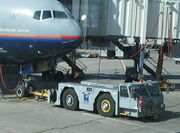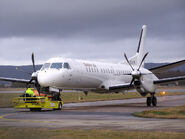
Cargolux Boeing 747-400 being pushed back by tractor
Airbus A380 pushback
In aviation, pushback is an airport procedure during which an aircraft is pushed backwards away from an airport gate by external power. Pushbacks are carried out by special, low-profile vehicles called pushback tractors or tugs.
Although many aircraft can also move backwards on the ground using reverse thrust (a procedure referred to as a powerback), the resulting jet blast or prop wash may cause damage to the terminal building or equipment. Engines close to the ground may also blow sand and debris forward and then suck it in to the engine, causing damage to the engine. A pushback using a tractor is therefore the preferred method to move the aircraft away from the gate.
Procedure[]
Pushbacks at busy aerodromes are usually subject to ground control clearance to facilitate ground movement on taxiways. Once clearance is obtained, the pilot will communicate with the pushback tractor driver (or a ground handler walking alongside the aircraft in some cases) to start the pushback. To communicate, a headset may be connected near the nose gear.
Since the pilots cannot see what is behind the aircraft, steering is done by the pushback tractor driver and not by the pilots. Depending on the aircraft type and airline procedure, a bypass pin may be temporarily installed into the nose gear to disconnect it from the aircraft's normal steering mechanism.
Once the pushback is completed, the towbar is disconnected, and the bypass pin is removed. The ground handler will show the bypass pin to the pilots to make it absolutely clear that it has been removed. The pushback is then complete, and the aircraft can start taxiing forward under its own power.
Equipment[]

A conventional tractor connected to a Boeing 777
Pushback tractors use a low profile design to fit under the aircraft nose. For sufficient traction, the tractor must be heavy, and most models can have extra ballast added. A typical tractor for large aircraft weighs up to 54 t (120,000 lb) and has a drawbar pull of 334 kN (75,000 lbf).[1] Often, the driver's cabin can be raised for increased visibility when reversing, and lowered to fit under aircraft.
Tractor types[]
There are two types of pushback tractors: conventional and towbarless (TBL).
Conventional tugs use tow bars to connect to the nose wheel of the aircraft. The tow bar can be connected at the front or the rear of the tractor, depending on whether the aircraft will be pushed or pulled. The towbar has a shear pin. The shear pin prevents the aircraft from being mishandled by the tug—when overstressed the shear pin will snap, disconnecting the bar from the nose gear to prevent damage to the aircraft and tug.

Towbars are used to connect the tractor to the aircraft.
Towbarless tractors do not use a towbar. They scoop up the nose wheel and lift it off the ground, allowing the tug to manoeuvre the aircraft. This allows better control of the aircraft, higher speeds, without anyone in the cockpit.[2] The main advantage of a towbarless tug is simplicity. By eliminating the towbar, operators are alleviated from maintaining many towbars. Also, the physical action and coordination required by the tug operator to move an aircraft with a TBL tug is simpler and easier to learn than with a towbar. By connecting the tug directly to the aircraft's landing gear - instead of through a towbar - tug operators have better control and responsiveness when maneuvering. This is most advantageous in general aviation settings, where operators are often required to move more aircraft (and a wider variety of aircraft) into smaller, more confined spaces than their airline counterparts.
Manufacturers of electric TBL tugs offer a line of models capable of moving any aircraft from the smallest single engine to narrow-body airliners, military cargo and airline-sized business jets. Just as specialized towbars are required for a wide range of aircraft, many TBL tugs use adapters which enable the movement of many unique aircraft. The majority of aircraft do not require adapters, and can be moved without any special adjustments to the tug. This is in contrast to conventional tugs, which often use so-called "universal" towbars that need to be adjusted for many aircraft types. Electric TBL tugs are gaining popularity among general aviation operators and FBOs as an alternative to gas-/diesel-powered, conventional tugs. Being electric- as opposed to internal combustion-powered, electric tugs are low-emission, a major advantage for environmentally-conscious operators. Also, this enables the tug to be safely operated inside a closed hangar.

The simplest way to ground handle an aircraft. This Aerotechnik EV-97A Eurostar is being pulled into position for refueling
Very small aircraft may be moved by human power alone. A short pushbar is attached to the nose gear to allow the aircraft to be steered without anyone at the aircraft controls.

david Brown Aircraft tug in RAF livery from WWII
The earliest such vehicle were adapted agricultural tractors in the 1930's. By the second world war as aircraft gor bigger and heavier modified tractors were commissioned specially for the job with crawler tractors being used for greater traction, but the lack of precision control soon lead to wheeled tractors becoming more common but fitted with a torque converter for smother take off with out snatching. the trctor were also built to push or pull with heavy duty hitches at both ends.
Military versions[]
| This section may require cleanup to meet Tractor Wiki's quality standards. (Consider using more specific cleanup instructions.) Please help improve this section if you can. The talk page may contain suggestions. |
In general, the military pushback vehicles are equivalent to the civil ones. But sometimes the Military need very compact ones who can maneuver on limited areas. This is important on aircraft carriers and in confined spaces, such as aircraft caverns or sometimes in Hardened Aircraft Shelters (HAS). Some military pushback tractors allow the driver to release the aircraft during the drive, which is useful for Quick Reaction Alert (QRA) out of the mountain caverns, as in the case of the Swiss Air Force Mirage IIIS. To prevent ignition these vehicles are powered by diesel engines (because of the limited fresh air circulation in mountain caverns and HAS the concentration of kerosene in the air can be higher as in a Shelter and the use of a gasoline motor could be dangerous). To tug out an aircraft in useful speed/time from a mountain cavern or HAS the tractors are equipped with a special light, often called visor. The driver has to follow with the beam of it at the markings that are painted on the ground. Because of the different size of the aircraft types there are different markings. Usually these military pushback tractors are able to supply fighters with electric power. Apart from towing jets and helicopters, they are also often used to tow mobile APUs, various weapons, as well as other equipment. The U.S. Navy uses the A/S32A-30-... aircraft ground support equipment towing tractor, called "Spotting dolly"-[3]
Other equipment applications[]
While the vehicle is referred to as a pushback tug, it is also used to tow aircraft in areas where taxiing the aircraft is not practical or unsafe, such as moving aircraft in and out of maintenance hangars, or moving aircraft that are not under their own power.
Some airlines, notably Virgin Atlantic, are now advocating towing aircraft to the holding point of the runway to save fuel and reduce environmental impact.[4]
Incidents[]
Incidents or accidents involving a pushback include:
- Garuda Indonesia Boeing 737-500, operating as Flight 238, collided with a Saudi Arabian Airlines Boeing 747-300. No casualties or injuries.
In the media[]
In an advertising campaign, also documented on the television show Fifth Gear, a Volkswagen Touareg was used to pull a Boeing 747. As cited before, the "tractor" needs to be heavy to aid traction. The Touareg carried 4.3 tons worth of cement bags, and the tires were inflated to twice the normal pressure to handle the extra weight. Tractor tires have high sidewall ratios for this reason.[5] This is the world record for the heaviest load towed by a production car.
Gallery[]
See also[]
- Aircraft ground handling
- FMC Technologies
- Ground Support Equipment
- Bliss-Fox Ground Support Equipment
- Visual Guidance Docking Systems (VGDS)
References[]
External links[]
| Add any external links that directly relate to this articles subject and have more info or have related images. Other general external links can be added to the web Site Links list. |
| This page uses some content from Wikipedia. The original article was at Pushback. The list of authors can be seen in the page history. As with Tractor & Construction Plant Wiki, the text of Wikipedia is available under the Creative Commons by Attribution License and/or GNU Free Documentation License. Please check page history for when the original article was copied to Wikia |







